MV
Prinses Margriet 1961 sold to Nauru in 1970 & Renamed MV Enna
G
Please
Note: Firefox and some other search engines are not
suitable – Use “Internet Explorer” for this page
to load perfectly!

Click
the logo above to reach the ssMaritime FrontPage for News Updates
& “Ship of the Month”
With
Reuben Goossens
Maritime
Historian, Cruise‘n’Ship Reviewer, Author &
Lecturer
Please
Note: All ssMaritime and my other related ssMaritime sites
are 100% non-commercial and privately owned sites. Be assured
that my sites have never been associated with any cruise or
shipping companies or travel/cruise agencies or any other
organisations! The author commenced working in the Passenger
Shipping Industry back in 1960 but is now very much retired and I
hope that the well over 625 articles on classic liners and cruise
ships that I have written will continue to inform and also bring
much joy to ship enthusiasts for many more years to come!
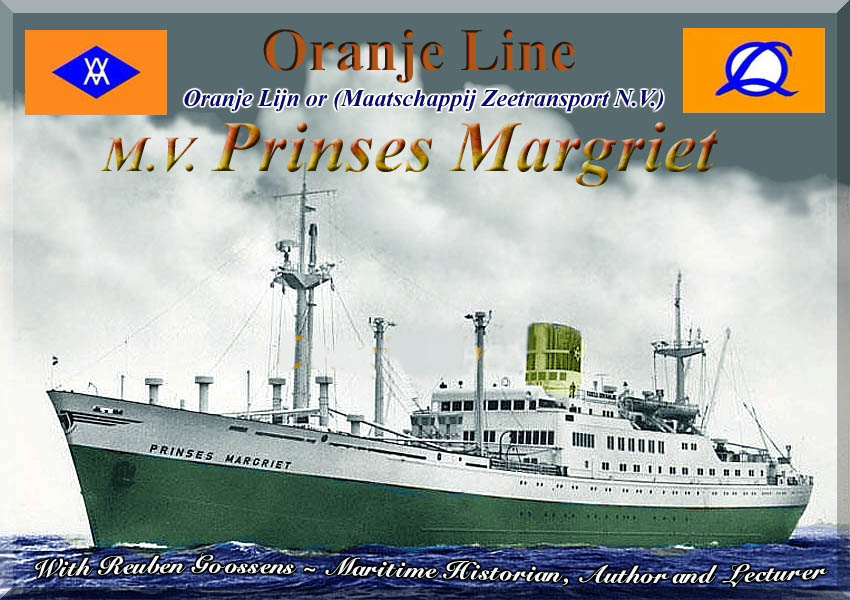
PLEASE
NOTE
Photographs
& Images are from a brochure or a deck Plan, whilst others
are from the author’s private collection or as noted!
Introduction:
I believe that this is a very special feature,
for it covers a special Dutch company that is not considered as
one of the greats of the world and to be honest, it certainly is
not counted as one of the greats. Yet the Oranje Line has a
fascinating history that began just in 1937 when a young man had
a grand vision!
This vision blossomed into a fine fleet of 27
great ships that included 15 cargo ships that carried between 6
to 12 passengers, as well as their three final superb
passenger-cargo liners which accommodated 60, 115 and 110
passengers. The two last ships were the most remarkable in design
and also for their super luxurious appointments; in addition
these ships were known for their fine service and sublime
dinning!
This feature will cover the early years and I
will just a mention several of the earlier ships as well and then
the company’s final three liners. But as you will have
noticed, I am highlighting the finest of them all the MS Prinses
Margriet, for she was in a way the Queen, the crowning glory of
the Oranje Line!
A
Background on the Oranje Line:
It would be on July 16, 1937 that a rather
young 23 year old Mr. Anthony Veder founded the “N.V.
Maatschappij Zeetransport” that later became known as
“Oranje Lijn” – Oranje Line! He had the idea to
commence transporting fruit and nuts from the south of North
Africa and Europe to further afield. Thus he purchased two ships
from Norway, which were known as “Lakers” ships that
were especially build to sail on the Great Lakes. These ships
were the “Harpefjell” and “Taborfjell” and
were respectively renamed “Prins Maurits” and
“Prins Frederik Hendrik.” Anthony Veder decided that
all the company ships would be named after the Dutch Royal
Family, although there was just one coaster the MS Nieuwaal in
1940 being the exception, but she hardly served for the company
as the WWII commenced and the Germans took her to Germany.
By the end of the war more ships would be built
and some would even commence to carry passengers in excellent
accommodations. In 1946 a ship that had been commenced prior to
the war, but was damaged and was left in her damaged state until
the builders could continue was the 2,680 GRT (Gross Registered
Tons) MS Prins Willem IV and she was the first AV ship to
offer accommodations for 12 passengers and operated on the
Rotterdam to Canada service.
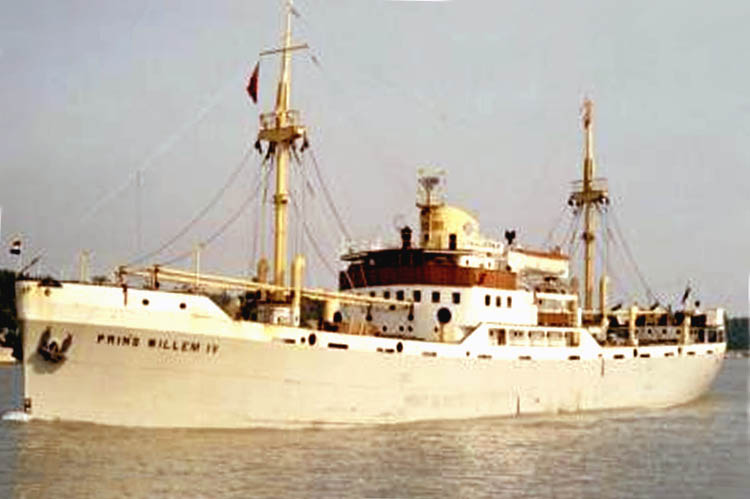
MS
Prins Willem IV; note her early livery, with a yellow funnel with
the AV logo for “Anthony Veder” on it
This
logo would remain until the company officially became the
“Oranje Lijn”
Other ships were soon built some operated as
cargo ships, whilst others carried from 6 to 12 passengers in
excellent accommodations. However, far greater things were to
come from this company that was now establishing itself in the
passenger trade from the Netherlands and the UK to Canada and the
USA!
The
First Passenger Cargo Liner for the Company:
The company’s very first actual
Passenger-Cargo liner was the MS Prins Willem van Oranje (2)
built in 1953, which offered excellent accommodations for 60
passengers, all accommodated on two decks. Those on the Upper
deck had three berths and the rest up on Passenger Deck with twin
bedded and all had private facilities. This Deck also had a
forward facing lounge, a spacious Dining Saloon along the
portside and the Bar located aft.
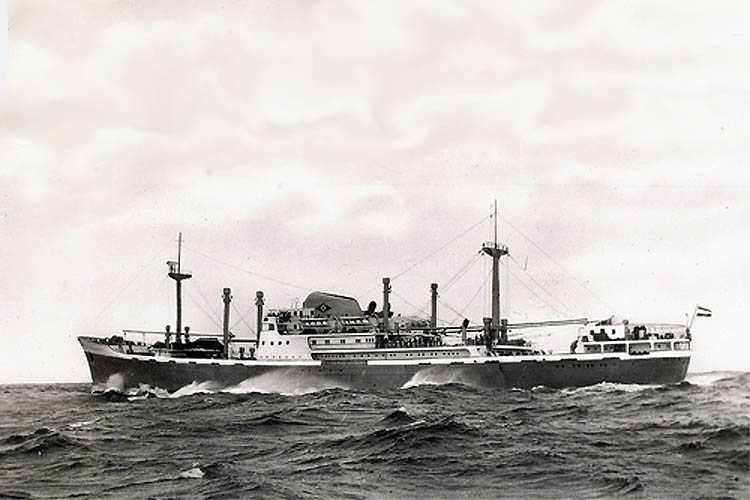
MS
Prins Willem-van-Oranje-2 was Holland’s fastest lines as she
achieved an excellent 20 knots during her trails!
MS
Prinses Irene:
The MS Prins Willem van Oranje was followed by
the far superior and much larger 8,525 GRT MS Prinses Irene was
built by “De Merwede” Hardinxveld, the Netherlands.

Here
we see an advance starboard side view illustration of Prinses
Irene, which was in building
She was launched by Dutch Royalty in July 1958
and she entered service in April 1959. She accommodated 115 One
Class passengers in superb accommodations and fine facilities.
Her accommodations were located on two decks and there were two
deluxe suites, and other cabins were for two all having private
facilities as well as folding beds, meaning that the cabin became
a lounge during the day. The external feature was the unusual
funnel with her curved blades that were designed for efficient
exhaust clearance!
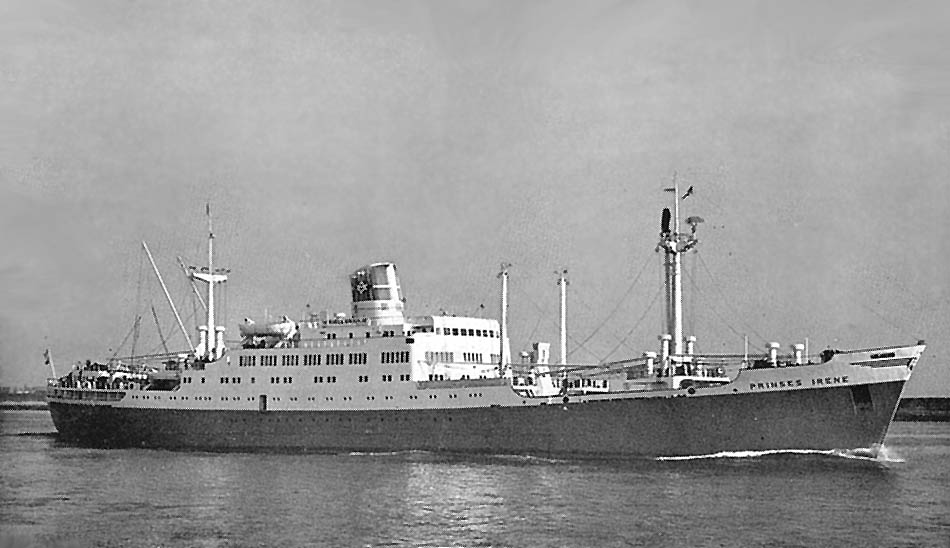
MS
Prinses Irene is seen now featuring the Oranje Line logo on her
funnel with the OL logo as see at the top of this page
MS Prinses Irene operated on the Netherlands to
the USA/Canada service; although during the offseason she would
make several round voyages to the Gulf of Mexico.
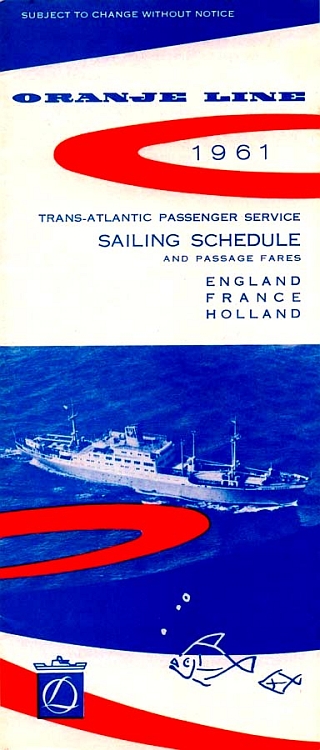
Here
we see the Orange Line 1961 Schedule which features both the
Prinses Irene and Prinses Margriet
However
it is the Prinses Irene that is featured on the cover of the
schedule
From June 1 to the end of September 1964
Prinses Irene was chartered to Cunard Line, after which in 1964
she was sold to Indonesia to be rebuilt into a passenger ship for
Muslin pilgrims and was renamed in 1965 “Tjut Njak
Dhien.” In 1978 she was sold to Indonesian Navy renamed
“Tanjung Oisina 972,” but the very next year in 1979
she was rebuilt into a troop transport ship. She became badly
neglected and she ended up beached near Djakarta where this once
beautiful and luxurious liner now lies there in a derelict state!
MS
Prinses Margriet:
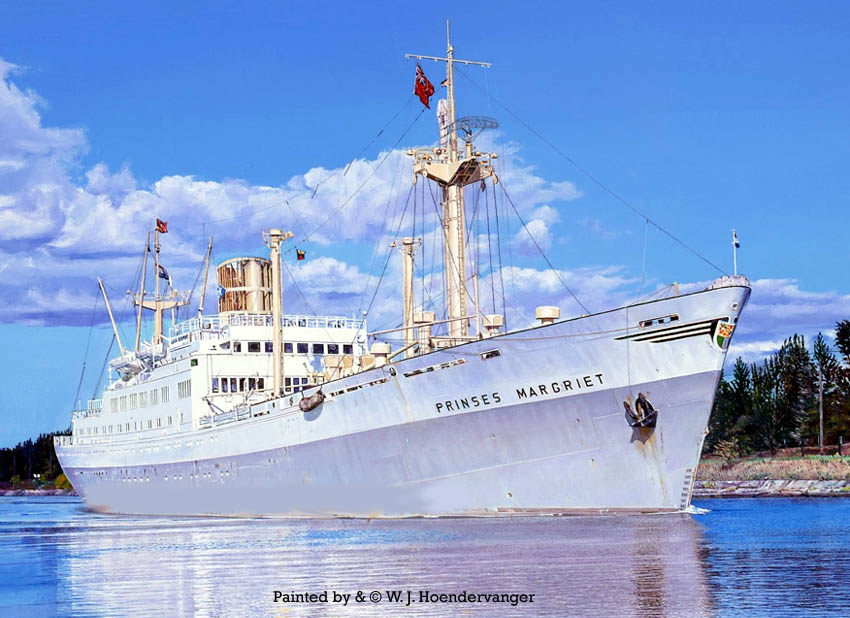
One
of the fine paintings of the Prinses Margriet by a great Dutch
Maritime Painter, Mr. W.J. Hoendervanger
For
further paintings by Mr Hoendervanger, Enter: www.wjmaritiem.nl
With MS Prinses Irene in service, the company
had their designer’s busy working on a new, but a slightly
larger ship. Yet it was decided that this new ship would be of a
similar design but far superior and more luxurious. This resulted
in the construction of the 9,423 GRT MS Princes Margriet, which
saw her keel plate laid down on March 1, 1960 at the “De
Merwede” Shipyards on the Merwede River at Hardinxveld,
which was close to Rotterdam in the Netherlands.
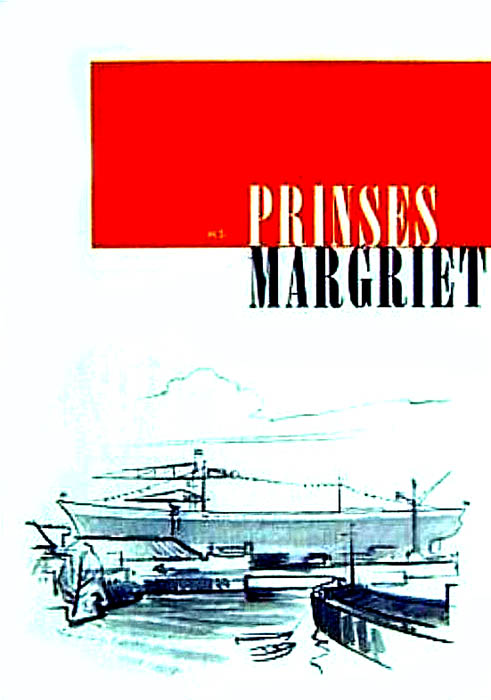
The
cover of the Preview folder with information on the Prinses
Margriet, this folder was handed to the Travel Industry on both
sides of the Atlantic
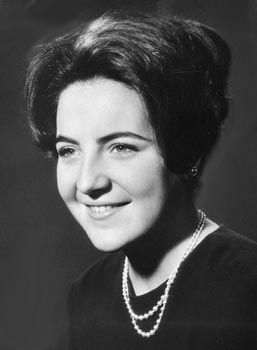 As I said earlier, Oranje Line’s
custom was to name all their ships after members of the Dutch
Royal Family, who are from the “House of “Oranje”
and their new liner would be officially named Prinses Margriet
and she was and remains to this day the “God Mother” of
the Dutch Merchant Navy, thus it was a worthy name for the Oranje
Line’s new ship!
As I said earlier, Oranje Line’s
custom was to name all their ships after members of the Dutch
Royal Family, who are from the “House of “Oranje”
and their new liner would be officially named Prinses Margriet
and she was and remains to this day the “God Mother” of
the Dutch Merchant Navy, thus it was a worthy name for the Oranje
Line’s new ship!
Then on December 10, 1960 the Oranje Line
passenger-cargo Liner, the Prinses Margriet was launched sadly
not launched by her namesake due to illness, but by her eldest
sister, Crown Princess, HRH Prinses Beatrix who did the honours
cutting the ribbon attached to the bottle of champagne that
smashed against her bow and she then slowly slipped down the
slipway. It certainly was a festive and a well attended event
with the burgers standing at every possible vantage point that
was available to see the new ship slide down into the Merwede River!
HRH
Prinses Margriet van Oranje
Once in the water, she headed to her fit-out
berth and was completed and painted and fully fitted out
internally to stringent conditions On June 6, 1961 she departed
for her sea trials which were successful, although at one point
she somehow stuck an underwater obstruction and when she returned
to port it was decided for her to enter dry dock to have her hull
checked, but with some minor hull damage being repaired she was
soon back in the water and after a few other minor changes on
board she was delivered to her owners on July 4, 1961 in
Rotterdam. There she was manned with her officers and her crew,
as well as being fully stocked for her passengers and crew needs
for her maiden voyage would commence very soon.
The
Ship and her Fittings:
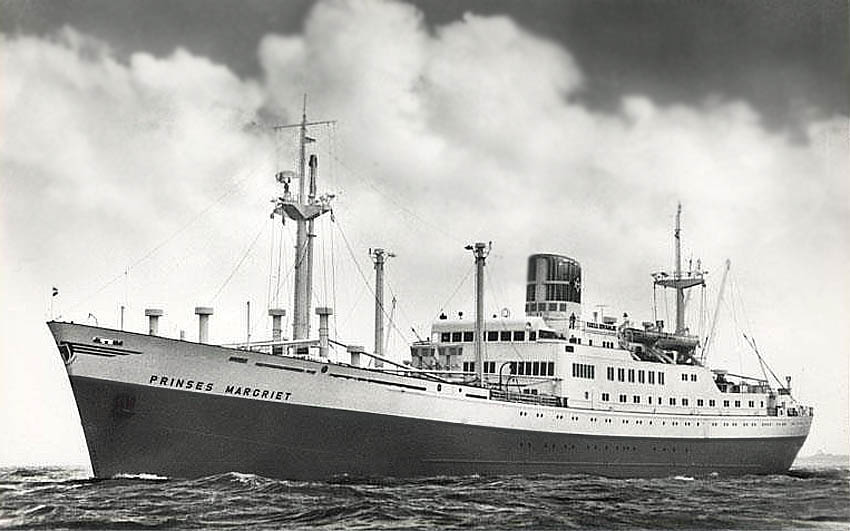
Oranje
Line’s - all new MV Prinses Margriet heading off to Canada
The Cargo Ship: Although having superb
passenger facilities, it must not be forgotten that she did have
a considerable cargo capacity, having five holds, three forward
and two aft, which were serviced by a total of thirteen derricks
from her two masts, sub kingposts and mini-kingposts.
Besides being a long and a sleek looking liner
with a beautifully shaped bow, her livery was a grey hull up to
just below her Upper Deck, with the rest and her superstructure
all in white. Her yellow funnel certainly stood out due to the
narrow vertical blades that surrounding most of the funnel. There
was a narrow horizontal bar surrounding the funnel and in the
centre there was the Oranje Line small “OL” logo. The
idea for the blades was in order that an airstream could flow
through the funnel and assist to carry the fumes away from the
ship.
The Passenger Liner: There are no doubts
that the MV Prinses Margriet’s interiors were acclaimed by
many for being “simply glamorous,” - “luxurious
and so full of charm.” Thus she was noted for her many
architectural and interior achievements and that included her
accommodations as well as the magnificent service that was
provided by her excellent crew. At the time all the reviewers
noted; “The Prinses Margriet is in my opinion the perfect
cargo-passenger ship, for she is a ship that has almost
everything a fine Atlantic liner would have.”
Public Facilities: Forward on Promenade
Deck there was the ships Main Lobby with its beautiful and
elegant curved staircase that served the three main passenger
decks, Promenade, Upper and Main Decks below. At the lobby there
were the large welcoming glass doors into the spacious and
glamorous Lounge that swept across the forward section of the
superstructure. The décor of this venue was sumptuous with
timber wall cladding with art works featuring in all the right
places, on there was quality blue and red patterned carpets and
the venue itself was superbly furnished with cosy sofas and
comfortable lounge chairs, However, the main feature of the venue
was the huge floor to ceiling windows that overlooked the bow and
the sides of the ship during the day, and were covered by red
drapes in the evening. Along the starboard side there was the
dance floor for there was music available for passengers to enjoy
their nightly dancing.
Regarding the brochure with her interiors,
considering I was unable to obtain any photographs of her
interiors from her Oranje Line days, I used those from the
brochure shown as well as her deck plan on the relevant page.
Then there is a collection of postcards and other exterior
photographs shown under both company liveries. But as you will
see that the brochure I used is from her Holland America days in
1964. Enjoy!
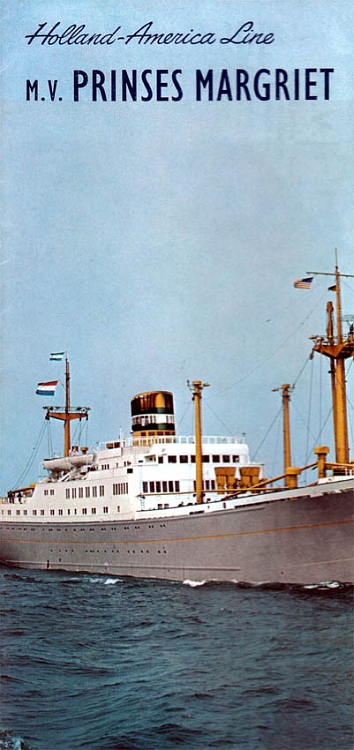
The
Holland America Line Brochure Cover of the MV Princess Margriet
as seen in 1964
All
the colour images below of her interiors and one deck photo were
sourced from this brochure which is from my private collection
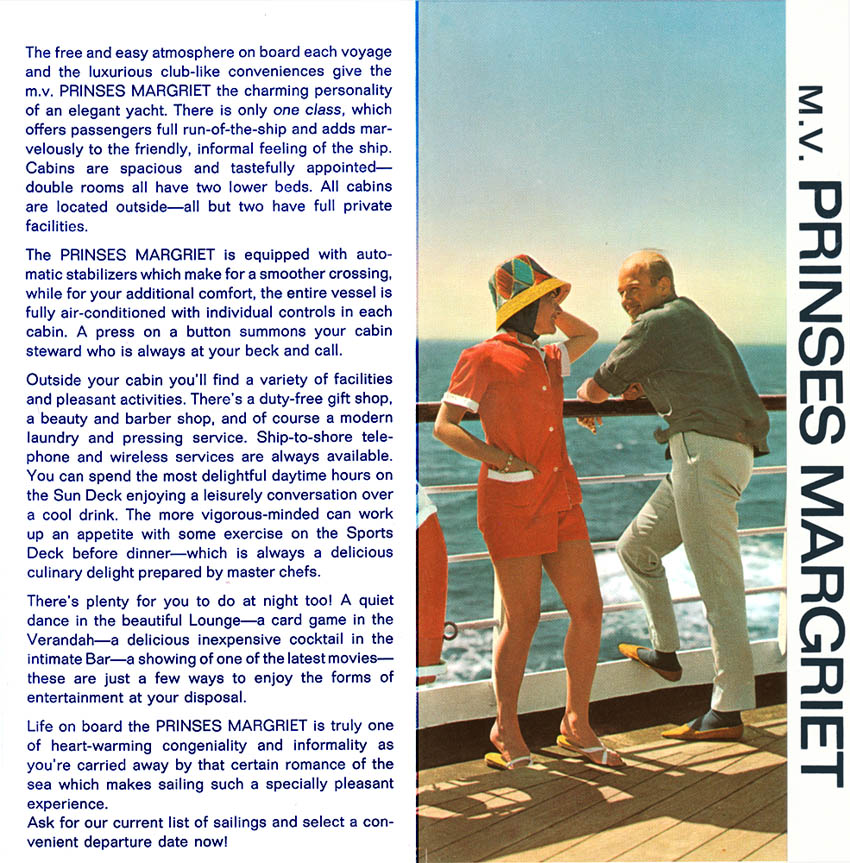
The
opening page of this four-fold brochure
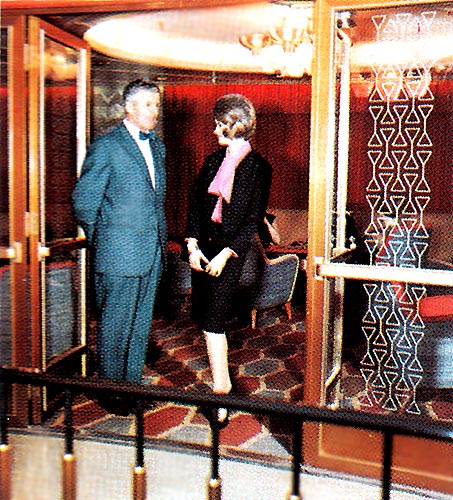
Entrance
to the Lounge as seen from the lobby and the curved
Stairwell
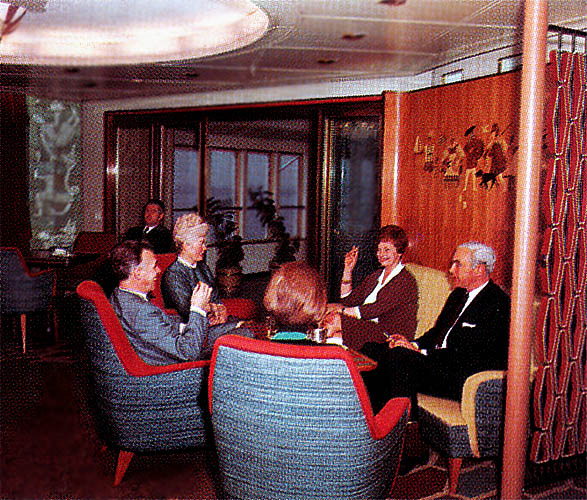
Starboard
corner of the Lounge looking into the Verandah
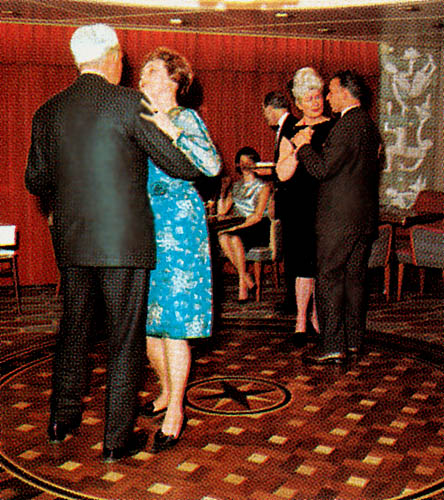
Just
forward of the above photograph is the dance floor, but note the
glass panel, which is also seen in the first photo!
On the port side of the Lounge, passengers
could enter the luxurious and spacious 64-seat Dining Room, thus
this venue was more than ample for her 111 First class Guests.
The décor was stunning and honestly it could well be perfect on
any 5 Star luxury cruise Ship, such as the Queen’s Grill on
a Cunard ship! Again it features those spacious windows, but more
importantly the cuisine on board was equally excellent and the
Oranje Line became famous for its presentation and quality! The
Galley was located aft of the Dining Room.
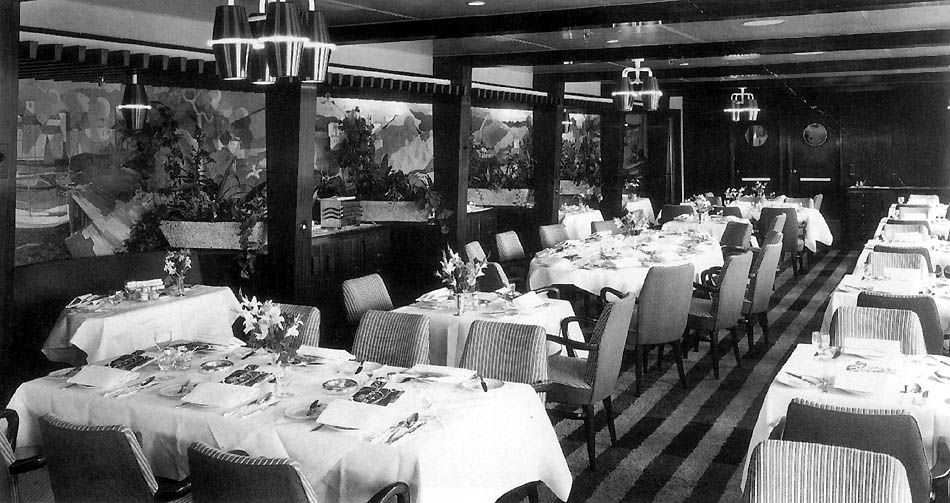
A
view of the dining Room looking aft towards the Galley, note the
alcoves and the beautiful artwork on the side walls
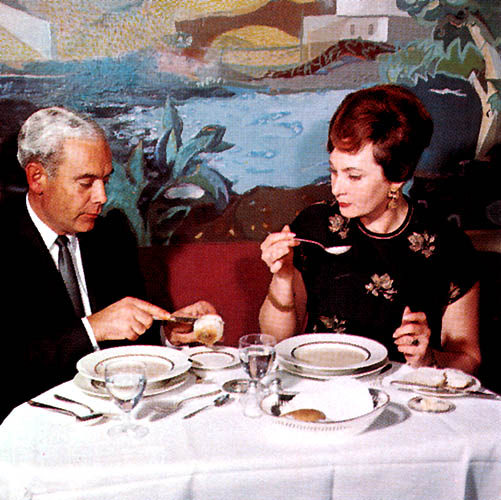
A
couple having a meal in one of the alcoves and it does features
the fine art
On the starboard side of the Lounge passengers
could enter through glass doors into the long Verandah and just
like the lounge there were those large windows the full length of
the Verandah.
The Verandah had an elegantly decorated lounge
area, with the aft long area being perfect location for
relaxation in comfortable deckchairs and tables whilst enjoying
the occasional refreshments and chatting with friends.
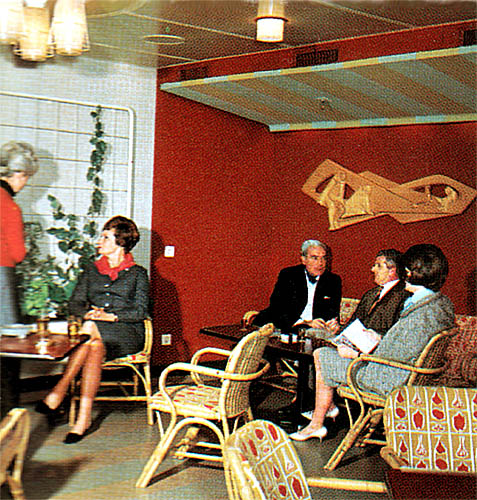
The
Verandah was a long fully glazed in area and a popular space for
relaxation whilst crossing the Atlantic
Also located on the Starboard side and
accessible from the Verandah was the Writing Room and Library.
This venue had an all timber cladding and bookcases with
attractive artworks featured on the walls. The furnishings was
the very same as used in the Lounge, except the carpets has a
small check pattern. Aft was the Library section with a sofa,
table and some lounge chairs, whilst forward here were the
writing desks with chairs.
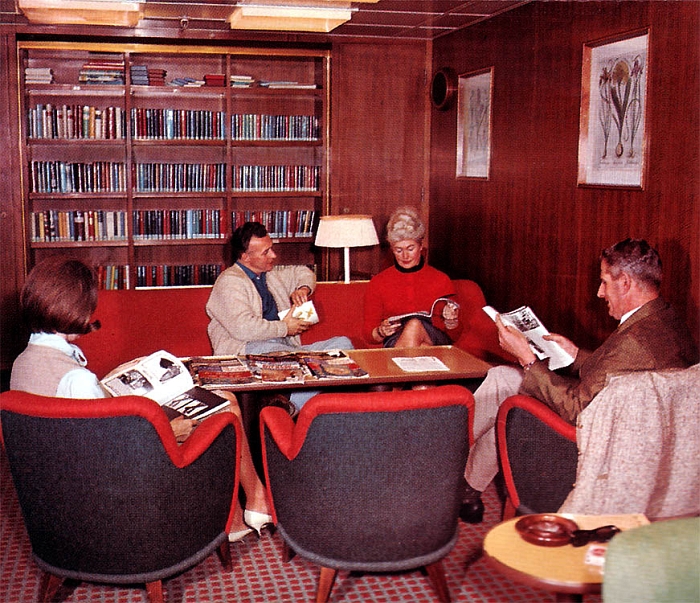
The
delightful Writing Room and Library
Aft and accessible from the Veranda was the
beautiful dark timber clad Ships Bar, which was obviously a very
popular venue onboard. The slanted and rounded bar was located
towards the starboard side of the venue, allowing ample space for
a lounge area for two three-seat sofas, two long timber tables
and four chairs. Middle aft of the venue there were two tables
with for chairs each and there were eight bar stools along the
Bar. Thus the venue could seat guests and that would overflow
into the well-furnished Verandah!
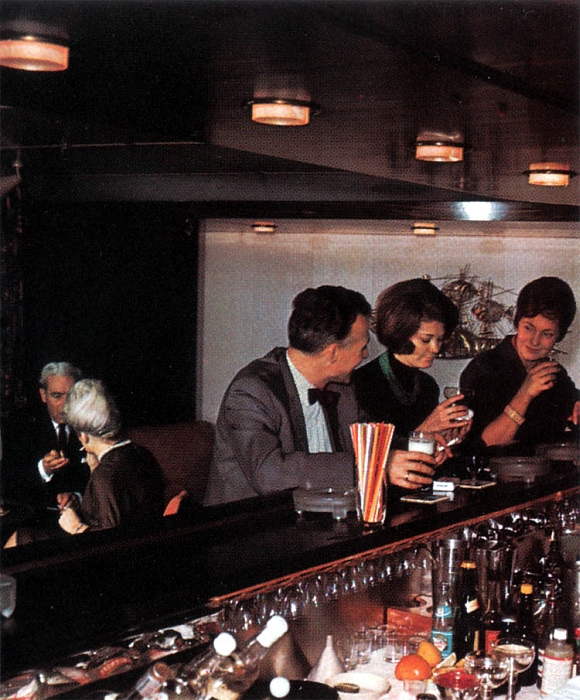
The
Ships Bar
With a spacious deck space aft of it and ideal
for sun baking or various minor sport activities, such as
shuffleboard, etc. Her top Deck “Sun Deck” was another
spacious deck for sunning or activities.
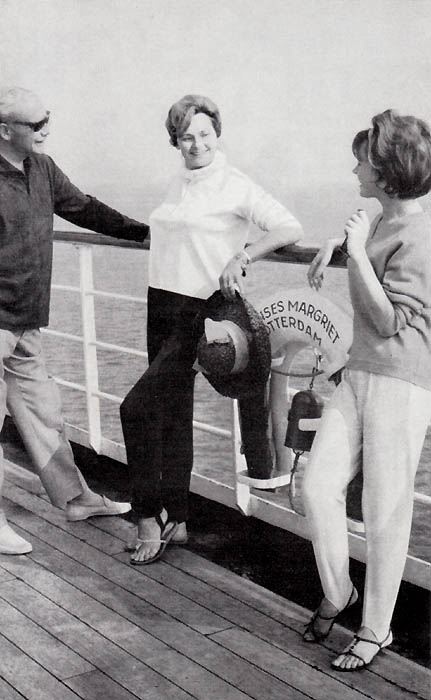
A
view of the deck space aft of Promenade deck
Accommodations: Her cabins were either
twin bedded or singled bedded rooms with *all having
private facilities. The majority had a bath with a shower
overhead, whilst the Single bed cabins bathrooms had a bathroom
with shower closet.
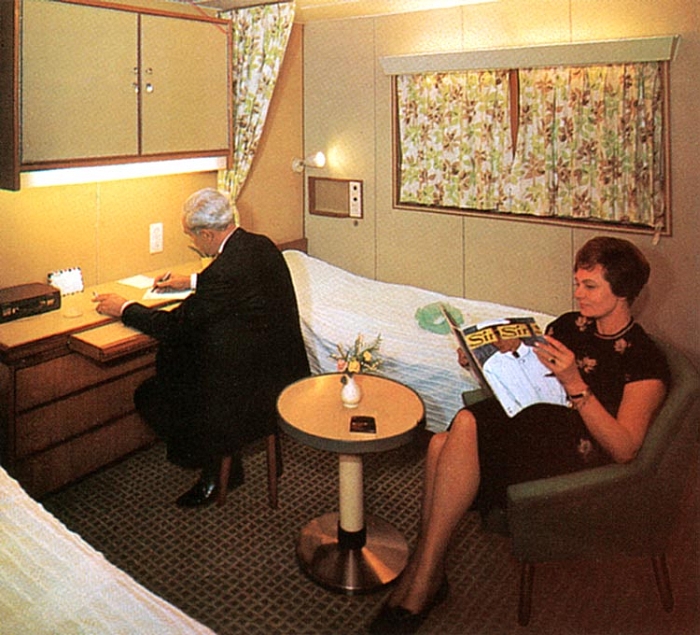
A
twin bedded cabin on Main Deck with private facilities
In all cabins one of the lower beds would fold
away and become a comfortable three-seat sofa during the day. In
addition, if required, one upper Pullman berth could be fitted in
some cabins only if a third passenger was travelling.
*On the Prinses Margriet there
were just two cabins located far aft on Upper Deck, numbers 32
and 33 that did not have private facilities. However, they did
have their private toilet directly outside of their door and
there was a single shower reserved exclusively for these two
cabins on the starboard side, opposite cabin 31, next to cabin
33. Thus it was not like on other ships where you had to wander
far afield at night to find the toilet, for it was right outside
your door!
Other Facilities: Aft on Boat Deck was
the Phone booth and the Radio Room. Of course in the early 1960s
the luxury of having a telephone in cabins was not as yet
available! The baggage Room was located one deck down on Upper
deck aft. Whilst located forward of the Lobby and the curved
stairwell on Main Deck, was what was known as the heart of the
ship, being of course the Purser’s Office and right next to
it was the Gift shop with the Hairdressers all neatly located
together. Whilst further aft on the portside was the
doctor’s reception room and there a small two-bed hospital
located further aft!
There was no doubt, but the late and the famed
Maritime Historian Mr. Laurence Dunn who published the much loved
Books, entitled: “Passenger Liners” certainly loved
this delightful ship and he said in his book (she is) …
“a ship notable for her charm, excellence of accommodation
and also service.” Thus this great man, I once knew is very
much agrees with me when it comes to this amazing little liner!
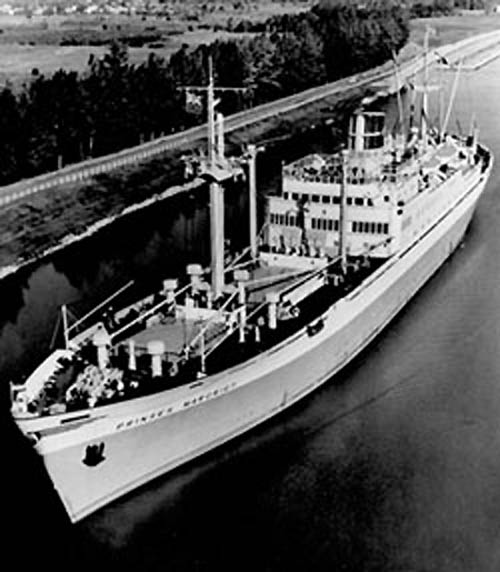
MV
Prinses Margriet is seen sailing on the “Nieuwe
Waterweg” heading for the North Sea
Now a
Note of Fact:
However, by the time this perfectly designed
passenger-cargo ship arrived on the scene, the truth is that it
was really too late, for the time for this type of passenger
transport was tragically on the way out! Today, we realise of
course that slowly it would affect all of the passenger shipping
trade and all major liners would be slowly either sold off or
change direction and be refitted or rebuilt to operate in the
more profitable cruise service! But small ships with around a 100
passengers were not suitable for the cruise industry, well not
for very long any way for the demand would be for better and more
facilities.
Her
History:
Having been completed and delivered, she was
fully stored and made ready for her maiden voyage on July 12,
1961. She first sailed to Antwerp and Hamburg for the reason to
load cargo as well as Belgium and German passengers. She then
returned to Rotterdam. This is a six-day round voyage not
including the day of departure. Her Dutch passengers would now
board and she commenced her first Trans-Atlantic crossing.
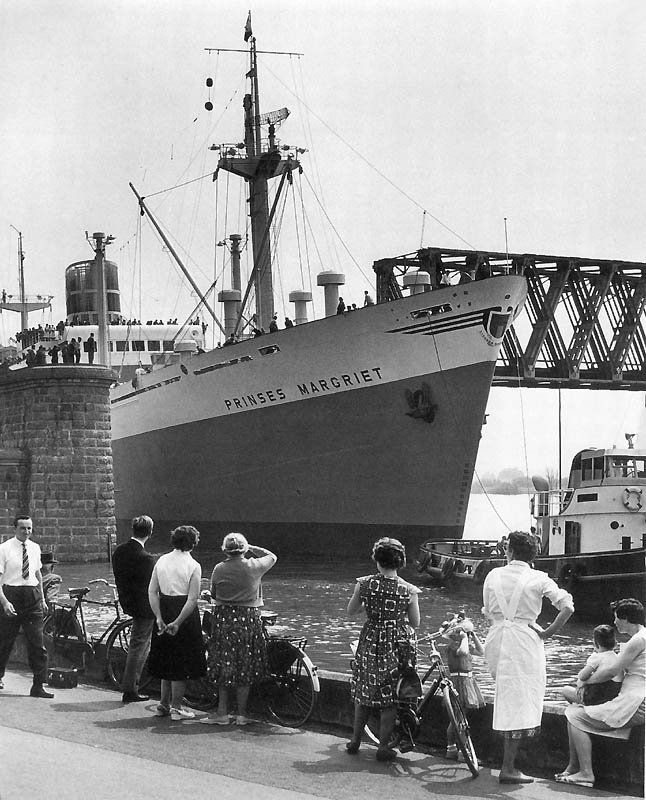
Prinses
Margriet returns from Antwerp & Hamburg to Rotterdam during
her Maiden Voyage on July 19
She
would now collect her Dutch passengers and depart for her maiden
Trans-Atlantic Voyage
Ports of call: Cowes Roads in order to
collect further passengers, Le, Havre. From France it was across
the Atlantic and up the St Lawrence to Montreal (two days), Chicago
(nine days), Sarnia, and up the St Lawrence River again to Detroit
(three days) and Montreal, returning to Plymouth, Le Havre, Rotterdam,
where she would offload some of her passengers, and continue to Antwerp
and Hamburg. The return Hamburg voyage would take a good sixty
days. On later voyages, she would also make calls to Toronto and Cleveland.
During the winter season some of these voyages
were simply not possible for many ships, but as the Prinses
Margriet having an ice-strengthened hull, she was able to sail
longer than most ships, but this was a difficult region!
Therefore between July 1961 and May 1963 the Prinses Margriet was
only able to undertake six prolonged voyages far into the North
American Continent and just two sailings that were able to head
up the St Lawrence River to Montreal before the cold and ice
closed it in. But those were the same problem encountered by all
companies!

A
special Anniversary Brochure as the Oranje Line was celebrating
25 Years in the shipping industry in 1962!
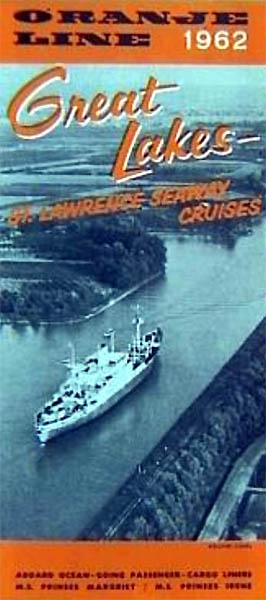
1962
sailing schedule for both the Prinses Irene and Margriet
The Oranje Line decided that during these times
to operate her and her sister the Prinses Irene on the
Europe/Rotterdam to New York service and even used the Prinses
Margriet during the winter of 1961-62 several voyages to the America
and the Mexican Gulf, which was popular with passengers. Ports
were as follows: Rotterdam to Plymouth, Miami, Vera Cruz, Tampico,
Coatzacoalcos, New Orleans, and Nassau back to Rotterdam. Then
during the winter of 1962-63 the ship operated two cruises from Rotterdam
via the Mediterranean to Haifa, Israel.
However, by early 1963 Oranje Line began to
realise that somehow that their passenger operations sadly were
just no longer a financially viable. Thus urgent decision needed
to be taken. It was decided that the 60 passenger, 1953 built MS
Prins Willem van Oranje would now operate just as a cargo ship
only and the Prinses Irene was chartered to Cunard Line in 1964,
and later that year she was sold to an Indonesian company or her
to be converted to become a pilgrim ship.
Times
are a Changing & Holland America Line:
Thus Oranje Line commenced to think of selling
the pride of their fleet in the near future, then a little later
in 1964 she was chartered by “Nederlandsch-Amerikaansche
Stoomvaart Maatschappij N.V.,” Rotterdam, or the
“Holland America Line (HAL), which had its head office in Rotterdam.
They placed her on what they called on their fortnightly service
from Rotterdam to New York and she would operate together with
the popular passenger-cargo liner the 12,146 GRT MS Westerdam!
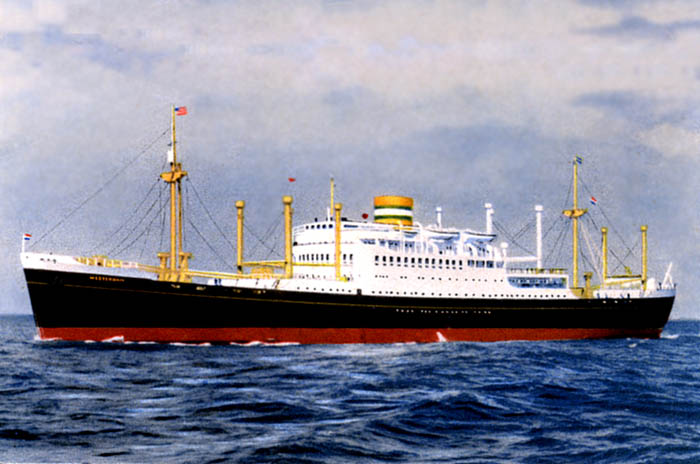
The
Holland America Line MS-Westerdam 2 - (1946-65)
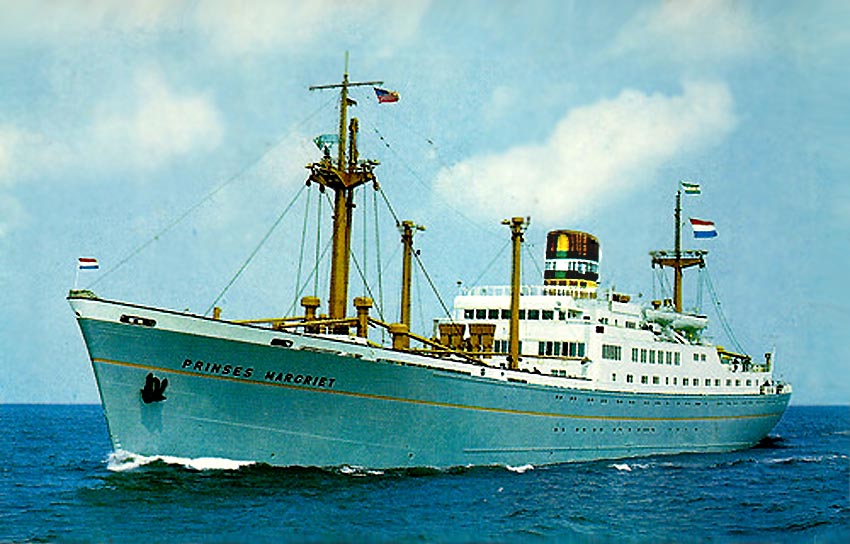
A
Holland America Line postcard of the MV Prinses Margriet
However, as the Prinses Margriet fitted in
perfectly in the HAL stable and being of a ship of such a high
quality, she was purchased outright by Holland America Line. Yet
the company decided not to rename this delightful ship in 1964.
Thus, the Prinses Margriet became a very rare ship in the HAL
fleet, in that she never had the traditional Holland America Line
“dam” at the end of her name, like Westerdam.
But, for the first nine years she remained very much the same
luxury liner that was built by Oranje Line, although the ships
Livery had changed, with her funnel now being yellow with the
traditional HAL two green bands with the white one in the middle.
She continued relatively successfully through
to 1970 and considering that countless ships were being withdrawn
during the 1960s, the Prinses Margriet did well to continue so
long, but she was popular with her passengers. Yet the Westerdam
was suddenly sold to the breakers late in 1964, but with the
success of the Prinses Margriet and she continued sailing. But it
was obvious that passenger loadings were not what they used to
be, although the repeat business was still good. But the other
factor was that cargo trade was changing with containerisation
slowly arriving on the scene. Thus the time came in 1970 that
Holland America was making a decision what to do with her and she
arrived to Rotterdam in June 1970 for the very last time! In all
MV Prinses Margriet had made an excellent 53˝ round voyages from
Rotterdam and New York
Her
Tragic Final Years:
Holland America sold the superb liner
officially in April 1970 to the Nauru Pacific Line, owned by
Nauru Government, but HAL continued to operate her until June of
that year. Having returned to Rotterdam she was taken to a
shipyard for some maintenance work and a refit, then in October
1970 she was officially transferred and registered in Nauru and
renamed Enna G, for the ship was named after Mrs. Enna Gadabu the
wife of Chief Ray Gadabu who was a famed early Nauru Chief!
Nauru Pacific Line changed her livery, with her
hull being painted all grey with only the amidships
superstructure and masts being white and it certainly did nothing
for her looks. Then her funnel was repainted in what was supposed
to be in symbolic colours and an interesting, if not a strange
explanation was given, but I did find it was interesting, but it
had problems. The Nauru Line claimed that her dark blue funnel
represented the ocean, not that I have ever seen the ocean that
was royal blue! The yellow band stood for the equator and the Island
of Nauru is located just south of the equator. Then there was
that large twelve-pointed white star located lower on the funnel
and this star was supposed to represent the twelve tribes in Nauru.
Thus it although it was all rather symbolic and someone in Nauru
would have had the brains to have carefully thought this all out,
thus the expectation would be that this wonderful ship would be
well run! But how wrong I was, for sadly over the next twenty
years the manner the ship was run, she was nothing short of a
financial disaster!
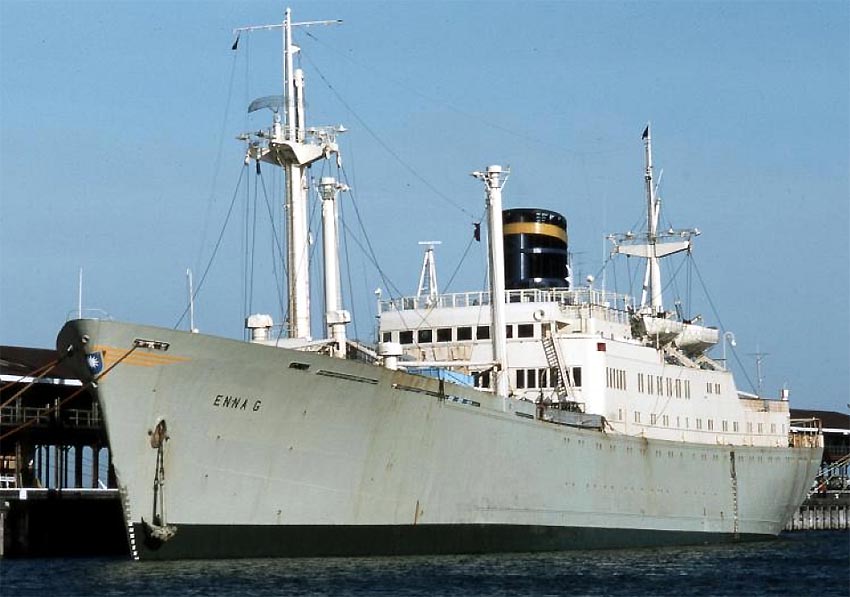
Here
we see the Enna G berthed, note the funnel colours, if that blue
represents the sea, then I am colour blind!
I know that I could tell a very long story
about this small dot of an Island nation named Nauru, that due to
copra suddenly became wealthy with the aid of Australia opting of
assisting in stripping this little country of just about all of
it in rapid time! Due to all this rapidly gained wealth they set
up a shipping company, as well as an Air Line and any local
citizen could make use of their ships or aircraft!
The ship was to be operated on the inter island
trade as well as the occasional voyage to Australia. There was a
time when the Enna G was filled with 111 schoolchildren who were
heading to Australian schools and this was the only time ever
that the ship had all her berths occupied! She returned to Nauru
without any passengers. Later she would also visit ports in Fiji,
Papua New Guinea as well as Guam; however that would decline for
passengers loading became almost non-existent due to the people
of Nauru deciding that it was better to use their airline rather
than go on the ship, which was too slow. Thus the Enna G sailed
mostly empty and with containerization having taken over in most
ports, she was not carrying much cargo as well!
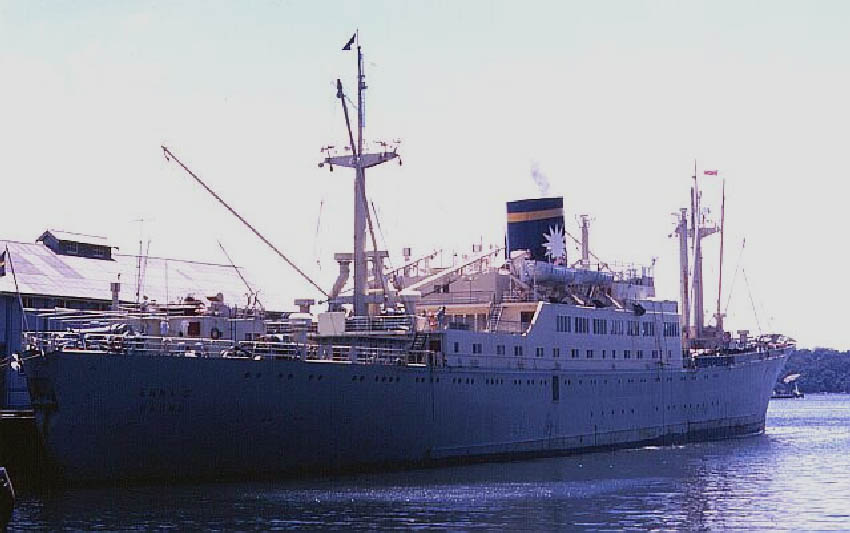
Above
and below are two photographs of the Enna G, one still berthed
and the next seen departing Sydney
Photographs
by & © Stan Evans Newcastle Australia
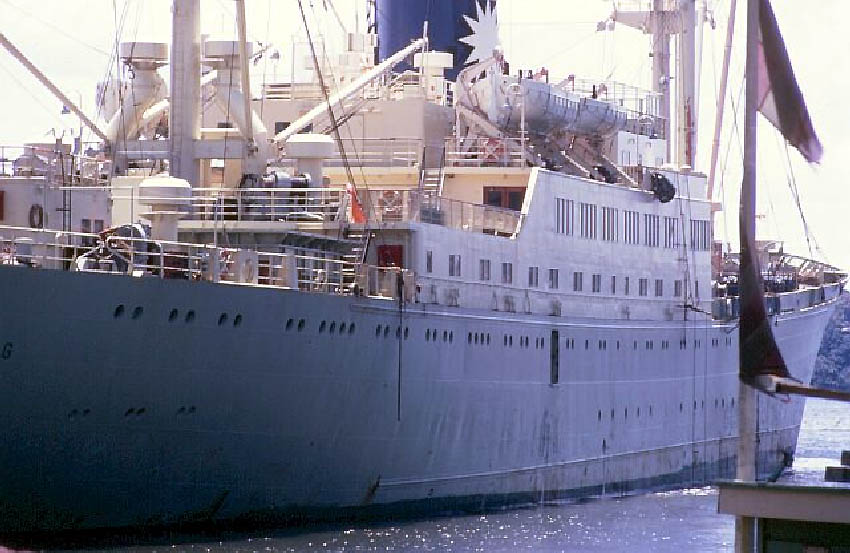
Having had a swimming pool installed in one of
her aft holds during a refit in Japan, it was decided to operate
her as a cruise ship out of Sydney and her first departure was in
May 1972. Apparently, occasionally she also carried some cargo,
but sadly the ship was plagued with mechanical problems and
breakdowns, due to maintenance problems. Then there were problems
with her crew, many of whom were Fijian and sadly the answer was,
just to sack them all. Due to the aforementioned, the Enna G was
laid up in Wellington New Zealand for four months for the severe
treatment of the native crew and although there was a meeting
between the Prime Minister of New Zealand and the President
of the Republic of Nauru, it became, as it was reported “a
heated one and came close to blows.” In addition, there were
the all too frequent arrests for non-payment of debts and it was
getting worse and worse as time would pass.
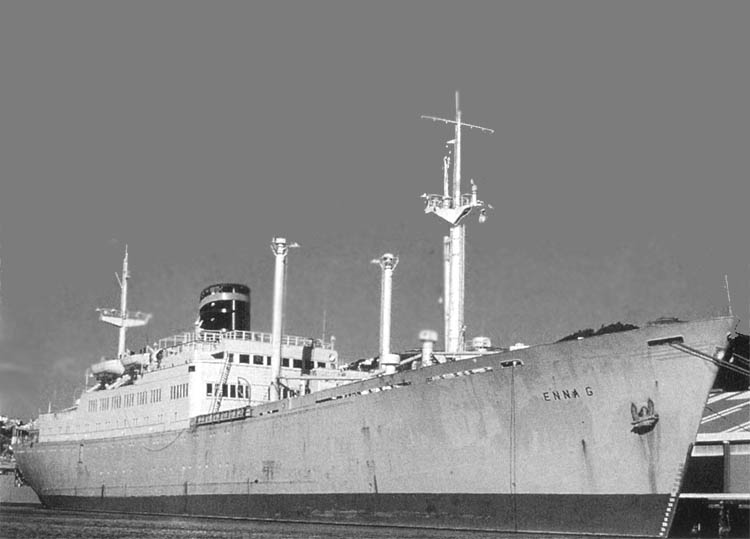
A
ship most miserable under arrest once again for non-payment of
debts, which was a regular event!
Considering she was unsuccessful both as a
cruise ship for her owners it was decided in 1973 to place her on
the Melbourne to Nauru service with visits to Sydney and Brisbane
as required.
In 1975 Enna G headed for Japan were she
receive a considerable refit, with the main purpose being to make
her suitable for the transport of containers. Thus, both her fore
and main mast was removed and two 10 tons cranes replaced her
loading gear. In order to cope with the new weight requirement,
her decks and hatches were reinforced as there would be three
containers stacked up high. In addition, her passenger
accommodation was slightly reduced to 103 passengers.
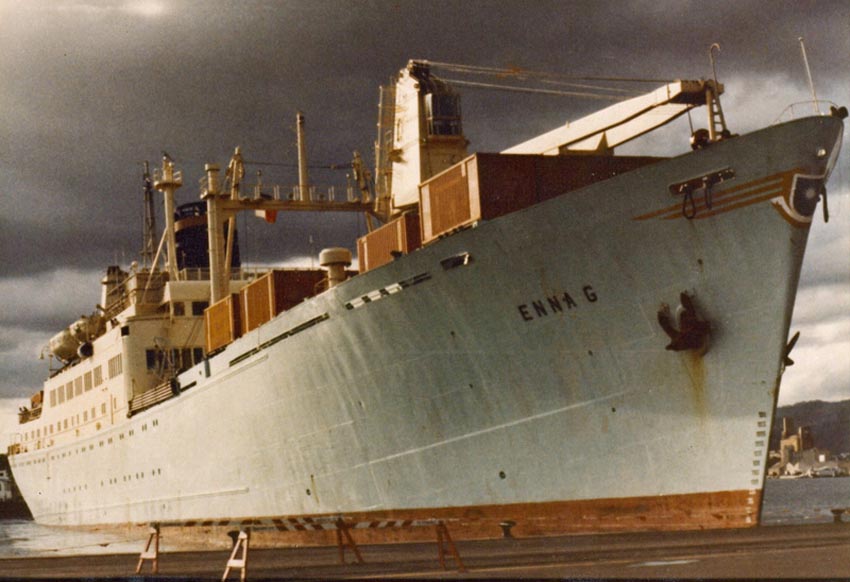
We
see her close to her final days
After her refit she operated a number of failed
services, then in 1977 the MV Enna G commenced a new Cruise and
Container service, including visits to a number of small Pacific
Islands such as; Majuro in the Marshall Islands, Ponape in Micronesia,
Truk in the Caroline Islands, Saipan in the American Governed Mariana
Islands and then to Honolulu and San Francisco, her new service
began fairly successfully as a cruise and cargo liner but However
considering that the MV Enna G was a foreign ship she was
prevented to operate a passengers service due to “cabotage
laws” between any of American administered Islands in the
Pacific, especially Honolulu in Hawaii and the USA Mainland
ports! It was decided to continue the operation on a cargo basis
only, however soon enough with her high fuel consumption and
exceptionally low cargo loadings, being mostly due to the larger
and more fuel efficient ships were now taking the majority of the
available cargo, thus sadly the Enna G became a burden for the
company.
In 1980 the ownership of the Nauru Pacific Line
vessels were transferred from the “Local Government Council
of Nauru” to the “Nauru Corporation (Victoria)
Inc.”, but all ships remained registered in Nauru. But it
had become obvious that the Enna G somehow had to make herself
economically accountable.
She continued to operate from Melbourne to
Nauru transporting containers and occasionally a few passengers,
but once again, considering due to the sheer inefficiency and
never ending breakdowns, due to maintenance problems she was
returned to Melbourne where the this tragic ship the Enna G was
laid up for twelve months. She was first located alongside the
“Duke” dry-dock and then she was languishing next to
the “Orr” dry-dock. Living aboard were four men who
were mostly being paid to keep an eye on her as well as ensuring
that she would not be vandalised.
Her
End is Near:
This once great all First Class Luxury, Orange
Line and Holland America Line passenger-cargo liner certainly did
not fare well during her second phase as a ship owned by Nauru to
say the least! As I have said several times her times with Nauru
was simply “so tragic.”
Originally, some of the greatest of maritime
historians, including myself had laden this fine ship with
highest praise for not just being luxurious and glamorous, but
also a ship that offered the highest quality of service and
finest of meals. And that was something that the Enna G owned by
this tiny Island Nation failed to do. Let us be honest, the
people of Nauru had almost no genuine maritime background and due
to their poor management, they damaged this ships good name and
all that was good about this once superior little passenger-cargo
liner!
But, it was in 1983 that the final insult
arrived, as the Enna G was relocated to Majuro Atoll a tiny
atoll, so low that at some King Tides the Island could even
disappear, it is part of the Marshall Islands. Amazingly this sad
place would be her final official port of call as a Nauru owned
ship for the next port was the breakers yard!
With the Enna G having been having been laid-up
at Majuro Atoll for a long seven years she found in a disgusting
run down state, thus it was decided to finally sell her the Thai
Ship breakers in 1990.
As her engines were no longer operational
having been completely neglected, she departed undertow in August
of 1990 for her final voyage to Thap Sakae where she arrived on
September 8, at the “Ocean Steel Co. Ltd.” Breakers
Yard. However it was not until March 13, 1991 that her breaking
up began, and it was reported to be completed on July 14, 1991.
Comprehensive
Details & Specifications:
Shipbuilder:
“De Merwede” Shipbuilders, Hardinxveld The Netherlands.
Yard:
547.
IMO Number:
5285370.
Callsign:
PGVS.
Homeport &
Flag:---------Rotterdam/the Netherlands.
Keel laid down:
March 1, 1960.
Launch Date:
December 12, 1960.
Trials:
June 6, 1961.
Delivered:
July 4, 1961.
Maiden Voyage:
July 12, 1961.
Tonnage:
9,336.00 GRT (Gross Registered Tonnage).
.
7,763.00 Deadweight Tonnage.
Engine built at:
Verolme Machine Factory IJsselmonde N.V., Holland.
Engine details:
Motor, Oil, 2-stroke single-acting.
Engine Type:
Single 10-cylinder diesel engine of a M.A.N. design - 8,600 BHP.
Screws:
1.
Speed:
17.5 Knots.
Length:
456ft.
Beam:
61.1Ft.
Draught:
32.3Ft.
Decks:
5 passenger decks.
Passengers:
111 First Class.
Stabilized:
Yes.
Ships
Owners:
1961-1964:
Oranje Lijn N.V., Rotterdam, Netherlands 1961-1964.
1964-1970:
Holland America Line 1964-1970.
1970-1980:
MV Enna G - Nauru Shipping (Nauru Government) 1970-1980.
1980-1990.
MV Enna G - Nauru Corporation (Victoria) Inc., Nauru.
1990:
MV Enna - Ocean Steel Co. Ltd., Thai ship breakers.
Remembering
What was a Fine Classic
Passenger-Cargo
Liner ~ The MV Prinses Margriet
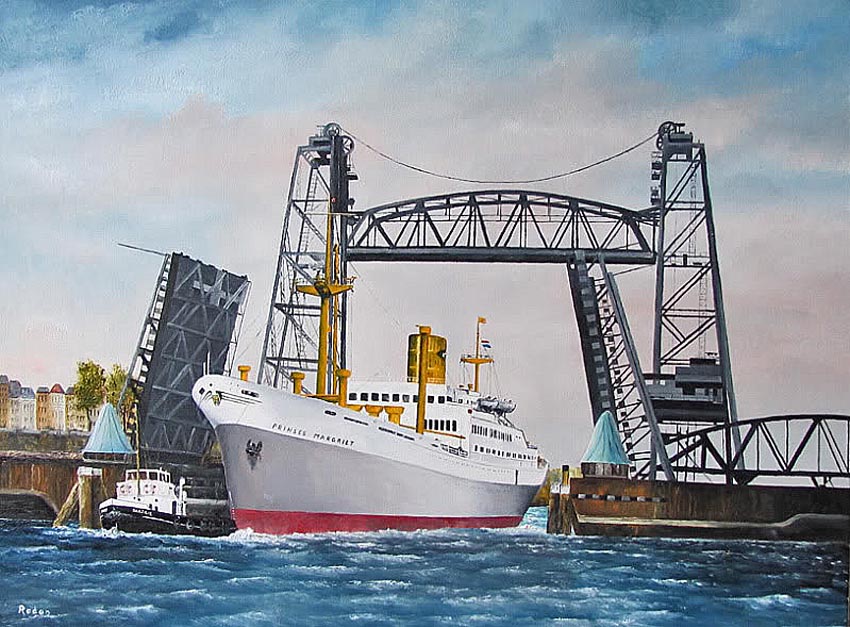
This
fine painting of the MV Prinses Margriet as seen in her Oranje
Line livery
A
fine painting by the excellent Dutch Maritime Painter Frans
Romeijnsen
Now
go and see her Deck Plan
As
well as further photographs, memorabilia and other items!
****************************
Visit our ssMaritime
Main INDEX
Where
you will discover more than 625 Classic Passenger &
Passenger-Cargo Liners!
ssMaritime.com & ssMaritime.net
Where
the ships of the past make history & the 1914 built MV Doulos
Story
Also
visit my
“Save The
Classic Liners Campaign”
Please
Note: ssmaritime and associated sites are 100% non-commercial
and the author seeks no funding or favours of any shape or form,
never have and never will!
Photographs
on ssmaritime and associate pages are by the author or from
the author’s private collection. In addition there are some
images that have been provided by Shipping Companies and private
photographers or collectors. Credit is given to all contributors.
However, there are some photographs provided to me without
details regarding the photographer/owner concerned. I hereby
invite if owners of these images would be so kind to make
them-selves known to me (my email address may be found on www.ssmaritime.com only), in order that due
credit may be given.
ssMaritime
is owned & © Copyright by Reuben Goossens - All Rights
Reserved.









 As I said earlier, Oranje Line’s
custom was to name all their ships after members of the Dutch
Royal Family, who are from the “House of “Oranje”
and their new liner would be officially named Prinses Margriet
and she was and remains to this day the “God Mother” of
the Dutch Merchant Navy, thus it was a worthy name for the Oranje
Line’s new ship!
As I said earlier, Oranje Line’s
custom was to name all their ships after members of the Dutch
Royal Family, who are from the “House of “Oranje”
and their new liner would be officially named Prinses Margriet
and she was and remains to this day the “God Mother” of
the Dutch Merchant Navy, thus it was a worthy name for the Oranje
Line’s new ship!























